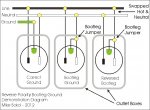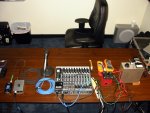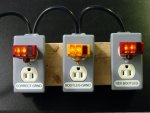jmsokol
Member
- Location
- Hagerstown, MD USA
I'm a technical instructor who teaches sound system installation at churches around the country, but my background is in industrial power and robotics control, and I earned my Master Electricians license in 1978. Over the last 10 years I've heard of many instances of musicians and preachers getting shocked on stage and in baptismal pools, so I'm always teaching about wiring safety for musicians and installers.
However, while drawing up a schematic of how 3-light outlet testers work, I noticed that they miss one really dangerous condition; something I call an RPBG (Reverse Polarity Bootleg Ground), where the Ground and Neutral contacts end up at 120 volts and the Hot contact is at 0 volts. See diagram below. Not to be confused with a CPBG (Correct Polarity Bootleg Ground), RPBG outlets are a very serious shock hazard since the grounds and neutrals are now at 120 volts, while the hot contact is at zero volts. Anything with a grounded power cord plugged into an RPBG outlet will seem to operate normally, but its chassis will be electrified to 120 volts which is extremely dangerous. The RV and Pro-Audio industry calls this a "hot-skin" or "hot-chassis" condition.
In pre-70's building renovations (without safety grounds) there's a need to install grounded receptacles. Electricians upgrading to grounded outlets sometime take a short cut, bonding the Neutral and Ground screws together in the outlet box creating a False/Bootleg Ground. If the white wire is actually neutral, it's not an immediate shock hazard (but against code). However, sometimes the white "Neutral" wire in the outlet box could actually be Hot. That's because black and white wires are sometimes swapped inside the walls, or there was knob and tube wiring which is all black. Note that an RPBG outlet will not show up using any ANY 3-light tester or even an advanced tester such as a Amprobe INSP-3, Ideal SureTest, or Extech CT-70. These advanced testers will show it's a Bootleg ground, but not detect it's an RPBG with a hot ground. See http://www.youtube.com/watch?v=iLk-6pvSlWg for a video.
With that in mind, here's a simple test I've developed using a non-contact AC tester to find RPBG outlets. A standard non-contact AC tester such as a Fluke 1AC-A II VoltAlert or Amprobe VP-600SB VoltProbe is sensitive enough to differentiate between the Hot and Neutral contacts on a NEMA 5-15 or 5-20 outlet, and will beep if the ground is hot. So my recommendation is to supplement your standard 3-light tester with a non-contact tester by checking the outlet in this order. Start on the Hot contact to make sure your tester beeps and doesn't have dead batteries, then move to the Neutral contact which should not beep, then the Ground slot which should not beep, then back to the Hot slot, which should beep. If the outlet is mis-wired as a RPBG, then you'll likely get beeping inches away from it since the front strap and entire metal box (if it's metal) will be energized to 120 volts. An RPBG outlet should be marked "out of service" until it can be repaired. Yes, most likely it should be replaced with a GFCI outlet and marked as "No Ground".
I'm already teaching this technique in my seminars for sound system installers, but it goes way beyond the music stage to every older home and office building that's been renovated to include grounded outlets. Please let me know if any of you have experienced this type of mis-wiring problem and how you found it. I appreciate your input.
Mike Sokol
However, while drawing up a schematic of how 3-light outlet testers work, I noticed that they miss one really dangerous condition; something I call an RPBG (Reverse Polarity Bootleg Ground), where the Ground and Neutral contacts end up at 120 volts and the Hot contact is at 0 volts. See diagram below. Not to be confused with a CPBG (Correct Polarity Bootleg Ground), RPBG outlets are a very serious shock hazard since the grounds and neutrals are now at 120 volts, while the hot contact is at zero volts. Anything with a grounded power cord plugged into an RPBG outlet will seem to operate normally, but its chassis will be electrified to 120 volts which is extremely dangerous. The RV and Pro-Audio industry calls this a "hot-skin" or "hot-chassis" condition.
In pre-70's building renovations (without safety grounds) there's a need to install grounded receptacles. Electricians upgrading to grounded outlets sometime take a short cut, bonding the Neutral and Ground screws together in the outlet box creating a False/Bootleg Ground. If the white wire is actually neutral, it's not an immediate shock hazard (but against code). However, sometimes the white "Neutral" wire in the outlet box could actually be Hot. That's because black and white wires are sometimes swapped inside the walls, or there was knob and tube wiring which is all black. Note that an RPBG outlet will not show up using any ANY 3-light tester or even an advanced tester such as a Amprobe INSP-3, Ideal SureTest, or Extech CT-70. These advanced testers will show it's a Bootleg ground, but not detect it's an RPBG with a hot ground. See http://www.youtube.com/watch?v=iLk-6pvSlWg for a video.
With that in mind, here's a simple test I've developed using a non-contact AC tester to find RPBG outlets. A standard non-contact AC tester such as a Fluke 1AC-A II VoltAlert or Amprobe VP-600SB VoltProbe is sensitive enough to differentiate between the Hot and Neutral contacts on a NEMA 5-15 or 5-20 outlet, and will beep if the ground is hot. So my recommendation is to supplement your standard 3-light tester with a non-contact tester by checking the outlet in this order. Start on the Hot contact to make sure your tester beeps and doesn't have dead batteries, then move to the Neutral contact which should not beep, then the Ground slot which should not beep, then back to the Hot slot, which should beep. If the outlet is mis-wired as a RPBG, then you'll likely get beeping inches away from it since the front strap and entire metal box (if it's metal) will be energized to 120 volts. An RPBG outlet should be marked "out of service" until it can be repaired. Yes, most likely it should be replaced with a GFCI outlet and marked as "No Ground".
I'm already teaching this technique in my seminars for sound system installers, but it goes way beyond the music stage to every older home and office building that's been renovated to include grounded outlets. Please let me know if any of you have experienced this type of mis-wiring problem and how you found it. I appreciate your input.
Mike Sokol




